How To Purchase Train Tickets for Europe (For The Best Price)
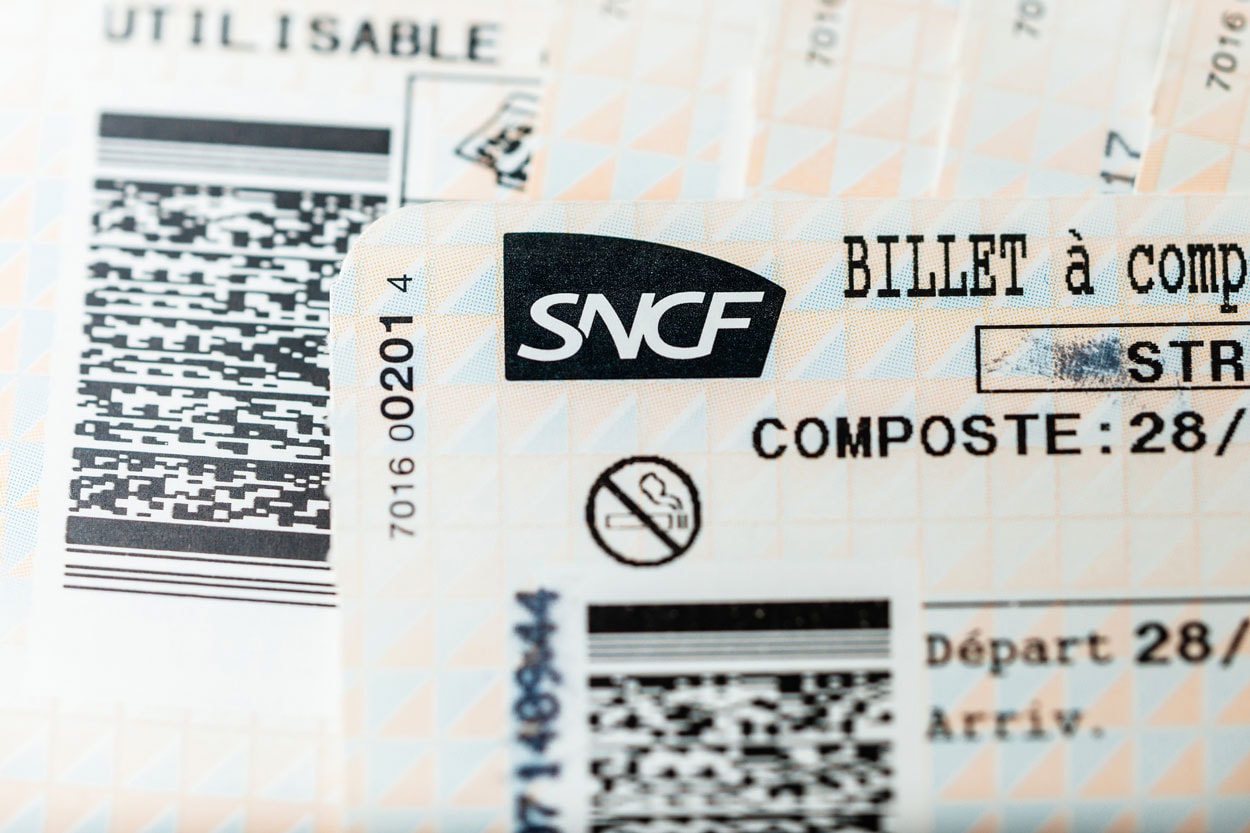
In the not-so-distant past, the only way to buy train tickets for Europe was through an expensive travel agent or at the train station ticket window. These days, most of Europe’s national rail services offer online booking and there are a handful of third-party booking sites that make buying tickets quick and easy—but there are still a few hiccups here and there.
In this guide, we’ll tell you everything you need to know about buying European train tickets—both online and at the train station.
If you’re looking for information about Europe rail passes, check out our guide to European rail passes.
The Two Main Types of Train Tickets in Europe
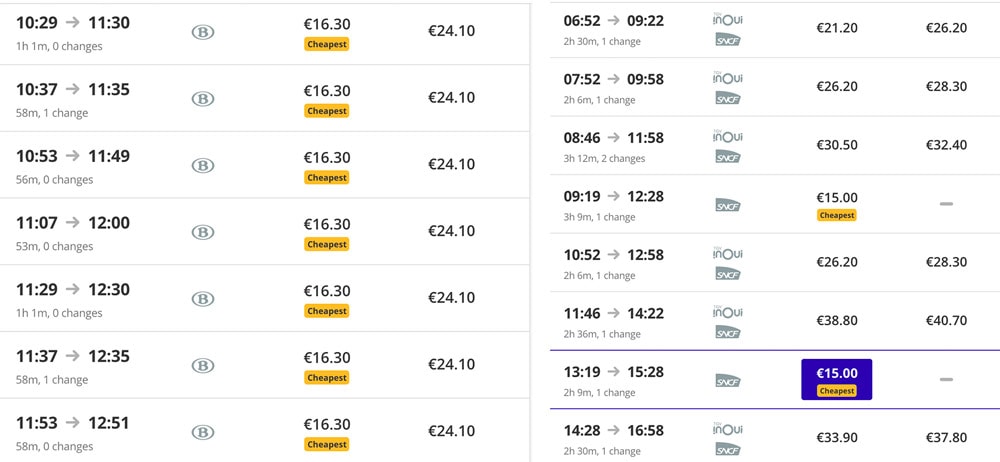
Before we get into buying train tickets, we need to talk about the two general ways that train tickets in Europe are priced. This should help you better understand how train ticket fares are calculated:
Fixed-Price Train Tickets
This is the most straightforward way train tickets are priced. In short, the price is solely based on the distance of the journey—i.e. the price is the same whether you buy it a month early or 2 minutes before the train arrives.
Just about every local and regional train uses fixed-price ticketing—so there are no discounts for buying early. Just show up at the station a little early and buy the ticket there. It’s as easy as that.
However, you can still often buy an electronic train ticket from Omio or Trainline so you can skip any ticket lines and have your tickets ready on your phone.
Furthermore, all domestic trains within Belgium, Luxembourg, the Netherlands, and Switzerland operate on this same fixed-price ticketing scheme—therefore, there is no financial reason to book ahead.
Variable Price Train Tickets
Most people who visit Europe end up traveling between major cities and these routes are almost always connected by high-speed trains.
Most high-speed trains and long/medium-distance trains use variable-price ticketing. That means the price is determined by route popularity, distance traveled, and when the ticket is booked—this is the same way airlines price their tickets.
The greatest factor that affects the ticket price is how early you book your train ticket—i.e. booking early = cheaper tickets. The difference between booking a month early and the same day can be staggering in some cases.
For example, a train ticket between Paris and Amsterdam starts around €35 but can be €120+ if booked last minute.
Note To Rail Pass Users
Variable price tickets (i.e. high-speed trains and long/medium-distance routes) often require a reservation. So, if you’re traveling with a Railpass, you’ll need to pay extra for the reservation (you can make this online or at the train station). However, Austria, Denmark, Germany, the UK, and most of Eastern Europe don’t require reservations on their trains (but you can still book one if you want a guaranteed seat).
Where To Buy Train Tickets In Europe
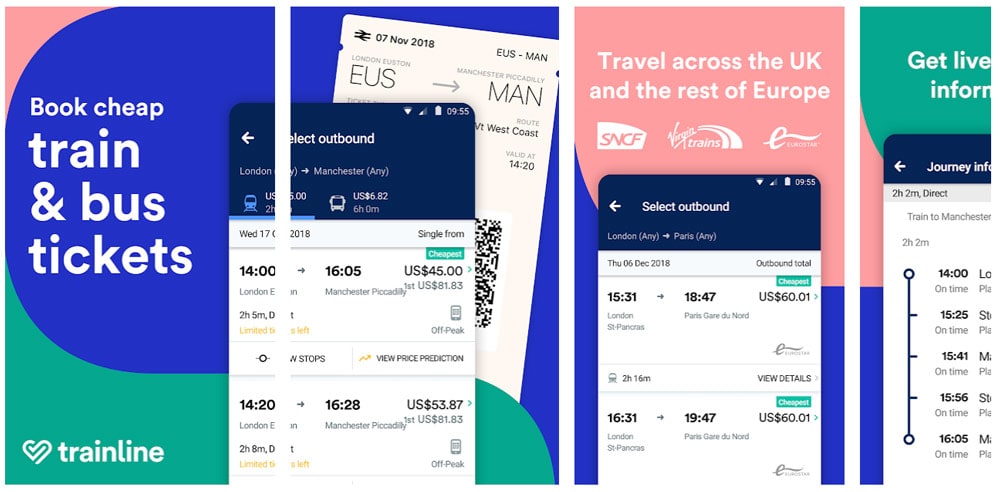
There are multiple ways to buy your train tickets and it’s actually become very easy over the past few years.
Buying Train Tickets Via Third-Party Retailers (My Preferred Method)
In most cases, the best way to purchase European train tickets is through a third-party booking website like Omio or Trainline.
These services are much more user-friendly than booking directly through each country’s national rail service. Yes, they charge around €1-€2 service charge but both services don’t mark up the actual tickets—it’s well worth the nominal extra fee.
Note: Both Trainline and Omio sell e-tickets that can be downloaded to their smartphone app or they’ll email you the digital tickets that the train conductor can scan from your phone (i.e. you don’t need to print them). If e-tickets aren’t available, you can pick the tickets up at the station.
Omio
Omio is my preferred train ticket booking engine because it lets you book tickets from just about every European country’s rail service. They make the booking process very user-friendly (i.e. you can use your credit card, you don’t have to worry about weird tech issues, etc.) and their smartphone app is super user-friendly. I’ve personally used Omio multiple times throughout Europe and it’s always been great. Visit Omio
Trainline
Trainline is another great train ticket booking engine that sells basically every country’s rail service and they also make the ticket-buying process simple (i.e. you can use your credit card, don’t have to worry about weird tech issues, etc.). Visit Trainline
Buying Tickets From European National Rail Service Websites
Each European country has its own rail service and most allow you to purchase tickets online (although some Eastern European countries are still behind the times so online booking might not be available).
However, many of these websites are plagued with bugs, they don’t always accept foreign credit cards, weird translation issues are common, and the overall user interface can be confusing.
This is usually the cheapest way to purchase train tickets because you don’t have to pay the $1-$3 service fee that Omio and Trainline charge… but I’d rather pay the small upcharge to not deal with the hassle.
Theoretically, all you need to do is purchase the ticket via the website and then collect the tickets at the train station. You’re often required to use the same credit card you used to purchase the ticket in order to collect your tickets. You’ll also need a card with a chip if you want to pick up your ticket from a machine. If you have a standard “swipe” card, you’ll have to go to the service desk.
Most rail services now use electronic tickets that can be sent to your smartphone or emailed to you (so there’s no need to print tickets anymore).
The best national rail service sites are:
Buying Train Tickets At The Station
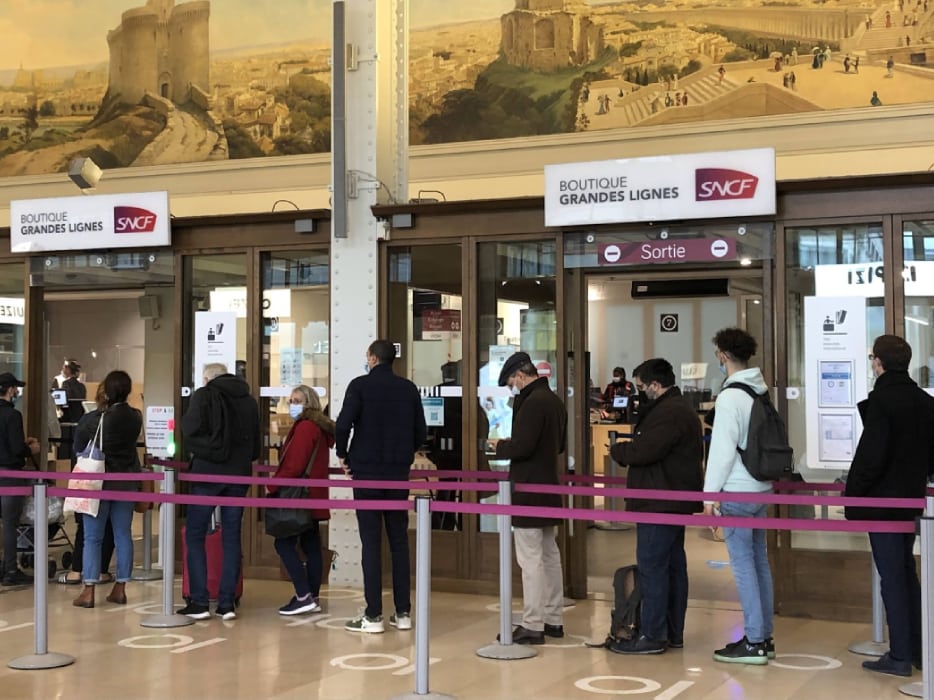
You always have the option to buy train tickets at the station—either from an electronic ticket machine or from the customer service window.
Don’t expect the person at the counter to speak English but they might. However, you can usually just write down where you want to go and the time you want to depart and they’ll sell you the ticket.
The main problem with buying train tickets at the station is the long line at customer service windows—especially at busy train stations. I’ve been in lines that have taken 45 minutes so get there early so visit during off-peak hours.
More than likely, you’ll use an automated ticket machine (they’ll all have English instructions) but every now and then you’ll run into a problem using a foreign credit card (this is another reason I travel with two different credit cards). I you have a problem, you’ll have to go to the customer service window or use cash (if the machine accepts cash).
Should You Buy Train Tickets Early? If So, How Early?
As mentioned before, it’s advisable to book at least one month in advance if you want the best ticket price on high-speed trains.
Most National Rail Services start selling train tickets 60-90 days before the date of departure.
Eurostar tickets are available for purchase 180 days in advance and you should snatch those tickets up as soon as possible. For example, a Eurostar ticket purchased 3-4 months in advance will cost around $70 and a ticket purchased on the day of departure can cost $300.
How to Find The Best European Train Tickets

Before you book your train ticket, it’s important to pay attention to the details of each ticket because there are multiple easy-to-overlook factors to consider that will impact the price, comfort, and convenience of your journey.
Number Of Transfers
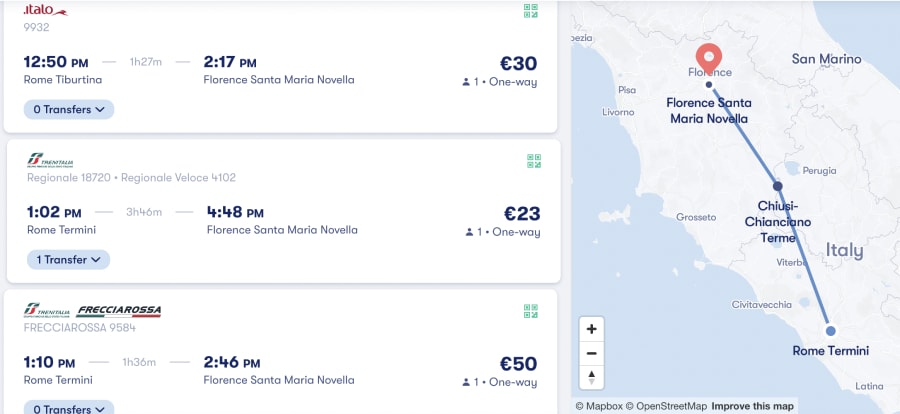
Always look at the number of transfers before booking your train tickets. I prefer booking train journeys with zero transfers since it’s much quicker and way less hassle—especially when traveling between major cities.
In the example above, the direct high-speed train from Rome to Florence costs a few euros more but you save more than two hours of travel time.
Fast Trains vs Slower Regional Trains
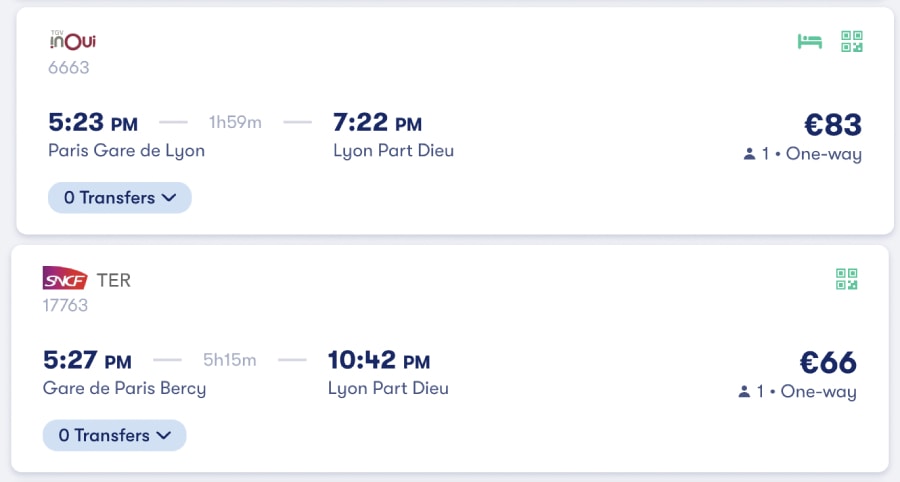
High-speed trains are typically more expensive than the slower regional trains but you’ll get to your destination much faster. High-speed trains are also typically more comfortable and modern so the ride is more enjoyable.
Your search results might not specially state that the train is a “high-speed train” so you’ll have to familiarize yourself with what each country calls its high-speed trains. For example: In France, the high-speed train is called the TVG (Trains à Grande Vitesse). In Italy, they have their FRECCIAROSSA, Italo, and Frecciargento high-speed trains.
In the screenshot above, you can see that the first result is a high-speed train that’s 3 hours faster than the slower regional train below it.
In short, always pay attention to the length of the journey so you don’t accidentally book a slow train.
Note The Train Station Name
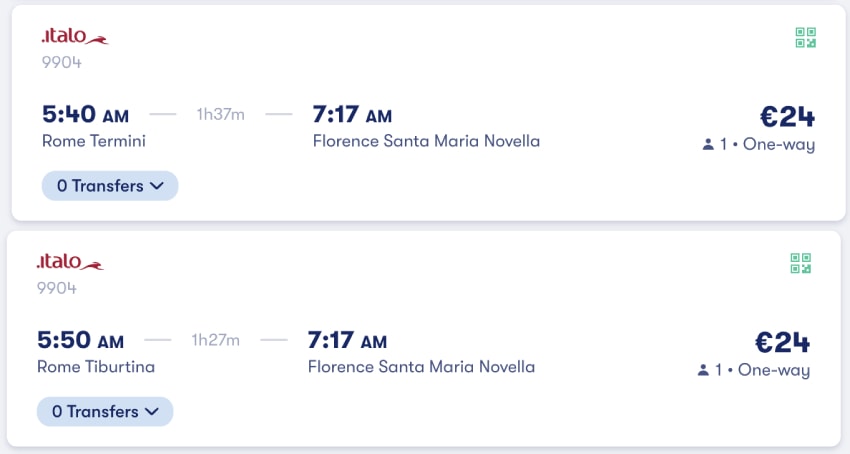
Most major European cities have multiple train stations so pay attention to the station name before booking (or at least before you show up at the station).
In the example above you can see that the first train departs from Rome’s Termini station (which is in the center of Rome) but the second leaves from Rome’s Tiburtina station (which is located in the northeastern part of the city).
Departure & Arrival Time
Your departure time can have a big effect on the price of your train tickets since the most popular travel times are often the most expensive.
You can often save a good amount of money by traveling during these non-peak hours.
Ticket Class
Most trains will have both first and second-class ticket options—typically a first-class ticket will be 1.5x the price of a second-class ticket.
I always opt for second-class tickets because the seats are plenty comfortable.
Cheap Tickets Are Often Non-Refundable
The main downside to booking cheap tickets in advance is that the tickets are often non-refundable and non-changeable (each service has slightly different terms). For most travelers, this isn’t a huge issue but it does limit some flexibility.
Each Country Has Its Own Quirks
The rail service in each European country operates slightly differently so I’ve written up a few country-specific trains guides to help:
More Tips For Traveling Europe By Train
Here are a few more in-depth articles about traveling Europe by train:

No Funny Business
The Savvy Backpacker is reader-supported. That means when you buy product/services through links on the site, I may earn an affiliate commission — it doesn’t cost you anything extra and it helps support the site.
Thanks For Reading! — James
Questions? Learn more about our Strict Advertising Policy and How To Support Us.

